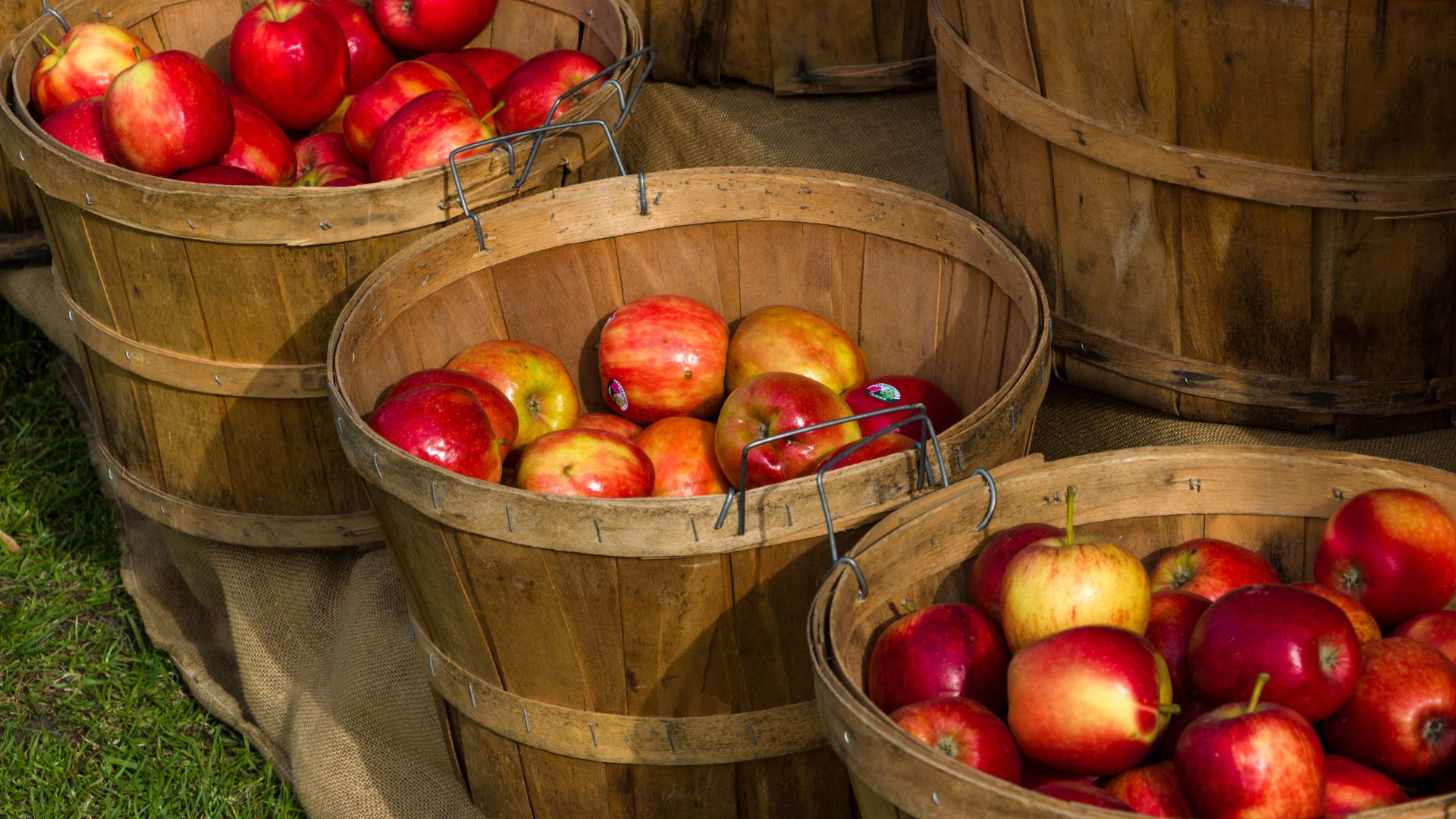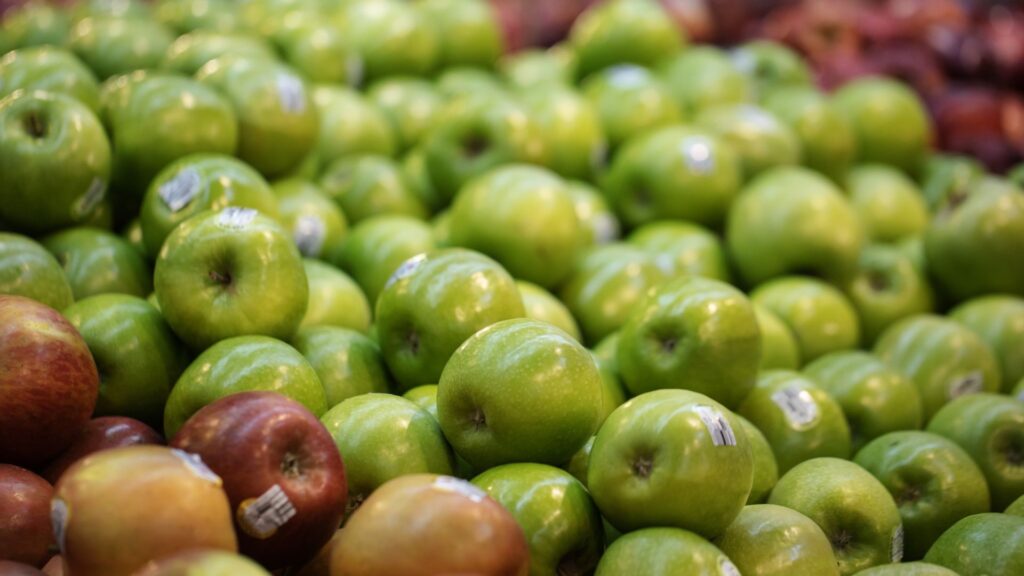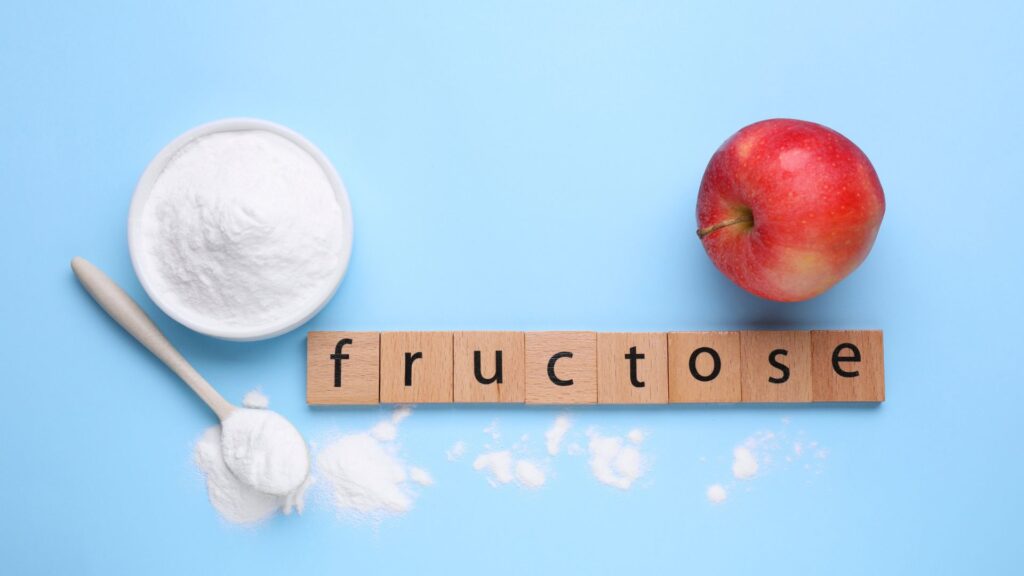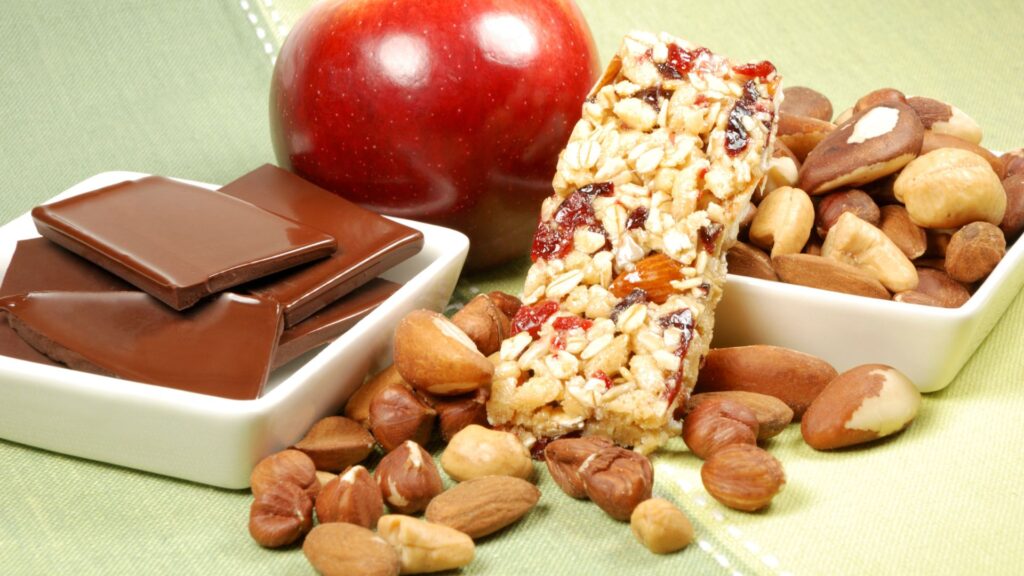Are you surprised that even healthy snacks like apples carry hidden dangers in calories?
With obesity on the rise, understanding what we eat is more crucial than ever.
But don’t worry.
Today’s blog post will guide you through the unexpected calorie traps in seemingly healthy fruits and offer you better calorie-smart alternatives.
Stay tuned to make your diet healthier without giving up on delicious treats!
Unpacking The Calorie Content Of Apples

Calorie Count Across Different Apple Varieties
When it comes to snacking on apples, not all varieties are created equal, especially in terms of calorie content. It’s a common misconception that all apples pack the same nutritional punch. However, the calorie count can vary significantly among different types. Here’s a comparison of some popular apple varieties:
- Granny Smith: Known for its bright green color and tart taste, a medium-sized Granny Smith apple contains about 95 calories. It’s a great choice for those watching their sugar intake due to its lower sugar content compared to other apples.
- Fuji: Originating from Japan, Fuji apples are sweeter and crisper. A medium Fuji apple packs around 110 calories, making it one of the sweeter, higher-calorie options.
- Gala: A favorite for snacking due to its mild sweetness and crisp texture, a medium Gala apple has approximately 95 calories, similar to the Granny Smith but with a different flavor profile.
The Effect of Apple Size on Calorie Count
It’s not just the apple variety influencing calorie content; size also matters. Generally, the larger the apple, the more calories it will contain due to the increased amount of fruit flesh. Here’s a simple guideline based on apple sizes:
- Small apple (about 2 ¼ inches in diameter): Typically contains 55 to 80 calories.
- Medium apple (about 3 inches in diameter): Can contain 90 to 100 calories.
- Large apple (more than 3 ¼ inches in diameter): May contain 110 to 120 calories or more.
Understanding these nuances can help you make an informed decision next time you reach for a quick snack. Choosing a smaller apple or a variety with lower calorie content can be a simple yet effective strategy for managing your daily caloric intake.
Nutritional Profile Beyond Calories

When we talk about the perks of biting into a crisp apple, there’s much more going on than the calorie count. Apples are a powerhouse of nutrition, packing a bunch of vitamins, minerals, and fiber into every bite. Here’s the lowdown on what makes this fruit a super snack:
Overview of vitamins, minerals, and fiber in apples
Vitamins: Apples are rich in vitamin C, which is essential for your immune system, and they also offer a good dose of vitamin K, which is linked to healthy bones. Plus, they provide a smattering of B vitamins, crucial for turning food into energy.
Minerals: Bite into an apple, and you’re crunching on calcium, potassium, and magnesium. Potassium is particularly notable for maintaining healthy blood pressure.
Fiber: This is where apples really shine. A medium apple provides about 4 to 5 grams of soluble and insoluble fiber, making up about 20% of the recommended intake. The fiber in apples not only supports digestion but also helps manage blood sugar levels by slowing down the absorption of glucose.
Understanding the role of fiber in feeling full and satisfied
One of Apple’s superpowers lies in its fiber content. Fiber isn’t just good for your gut; it plays a crucial role in weight management. Here’s how:
Keeps you feeling full longer: Fiber slows digestion, which means you feel full longer after eating an apple than a snack with little to no fiber. It helps curb overeating and unhealthy snacking.
Stabilizes blood sugar: By slowing glucose absorption, the fiber in apples helps prevent blood sugar spikes and crashes that can lead to hunger pangs shortly after eating.
Adding apples to your diet boosts essential nutrients and controls calories. Enjoy them raw, with peanut butter, or baked for versatility. An apple a day supports a healthy diet. In essence, the nutritional benefits of apples extend far beyond their caloric content, making them a smart choice for anyone looking to enrich their diet with foods that are as healthy as they are delicious.
The Sugar Story: Glycemic Index And Fructose
Navigating the sweet side of apples means understanding the fructose they pack and how they play into the glycemic index game. Here’s a straightforward scoop on what makes apples both sweet and smart snacking choices:

Natural Sugar Content in Apples
First off, apples contain natural sugar, predominantly fructose, which gives them their sweet taste. This sweetness can vary significantly between different types of apples:
Granny Smith apples: Lean on the tart side, meaning they have less fructose and are less sweet. Perfect for those who prefer a puckery punch over a sugary bite.
Fuji apples: Are like nature’s candy due to their higher fructose levels. They’re pretty sweet, making them a hit among sweet-tooth snackers.
Breakdown of Fructose Levels in Different Apple Types
Understanding the fructose content can help you make smarter choices, especially if you’re watching your sugar intake:
Low-Fructose Apples: Granny Smith, McIntosh, and Braeburn tend to have lower sugar levels. They’re sweet but not too sweet.
High-Fructose Apples: Fuji, Gala, and Honeycrisp are on the higher end of the sweetness scale due to their fructose richness.
The Concept of Glycemic Index and Where Apples Fall
The glycemic index (GI) measures how fast food increases your blood sugar. Here’s the deal with apples:
Apples have a moderate GI score, generally falling between 36 and 40. This means that they provide a more stable energy release than high-GI snacks.
Why it matters: Eating foods with a lower GI can help manage cravings and maintain energy levels, making apples a smart choice for steady snacking.
In simple terms, munching on an apple gives you a sweet treat without the rapid sugar spike and crash that come from more refined snacks. Whether you prefer the tartness of a Granny Smith or the sweetness of a Fuji, apples offer a range of flavors and benefits that cater to every palate, all while keeping your health in check.
The Impact Of Apple Consumption On Blood Sugar Levels
How the body processes the natural sugars found in apples
When you crunch into an apple, the natural sugars it contains, mainly fructose, make their way into your bloodstream. Unlike refined sugar, the fructose in apples is processed more slowly, thanks in part to the fruit’s fiber content, which acts as a speed bump, slowing down sugar absorption. This gradual process helps avoid the sudden spikes in blood sugar levels that can occur from eating foods high in refined sugars.
For example, having a Granny Smith apple might impact your blood sugar levels more gently than snacking on a candy bar, even though both may be sweet to the taste.
Tips for balancing fruit intake to avoid blood sugar spikes
Managing blood sugar doesn’t mean you have to give up fruits altogether. It’s all about balance and understanding how different foods can affect your body. Here are some practical tips:
- Mix it up with protein or healthy fats: Pair your apple with a handful of almonds or a slice of cheese. This combo slows down the absorption of sugar into your blood, providing a more stable energy source and keeping those hunger pangs at bay.
- Keep an eye on portion sizes: Even though apples are healthy, eating several in one sitting can add up in sugar content. Stick to one medium-sized apple as a serving.
- Be mindful of the time of day: Eating an apple with breakfast or as a part of a balanced meal can help manage blood sugar better than having it all by itself as a late-night snack.
Incorporating these strategies into your daily routine can help maintain a fruit intake balance while managing blood sugar levels effectively. Everyone’s body responds differently to foods, so it’s essential to monitor how you feel after eating and adjust accordingly. With a little planning and smart choices, you can enjoy apples’ sweet and crunchy benefits without worry.
Hidden Dangers In Overconsumption

When Healthy Eating Turns Harmful
While apples are packed with nutrients and offer numerous health benefits, it’s crucial to remember the old saying, “Too much of a good thing can be bad.” Despite their health halo, overeating apples can lead to unintended side effects.
The potential drawbacks of consuming too many apples
- Caloric Overload: Though apples are relatively low in calories, consuming them in large quantities can contribute to calorie surplus. For context, a medium-sized apple contains about 95 calories. Eating several apples a day can quickly add those numbers up, potentially leading to weight gain, especially if these calories exceed your daily energy needs.
- Fiber Overload: Apples are a good source of dietary fiber, but overconsumption can lead to gastrointestinal issues such as bloating, gas, and discomfort. A single medium apple contains about 4 grams of fiber, and consuming more than 25 to 30 grams of total dietary fiber daily can push the limits for some people.
How excessive apple consumption can affect dental health and weight
- Acidic Erosion: Apples contain natural acids that, while beneficial in moderation, can erode tooth enamel if consumed excessively. Constant exposure to these acids, especially in the form of juice or eating many apples throughout the day, can increase the risk of dental decay. Dental health and fruits, according to the American Dental Association (ADA), require a balanced approach to include fruits without overdoing it.
- Sugar Content and Weight: Despite being natural, the fructose in apples contributes to your daily sugar intake. Overindulging can inadvertently add extra calories and sugar, which, if not offset by physical activity or a balanced diet, leads to weight gain. Balancing how many apples you eat with consideration of how many calories are in an apple is crucial for maintaining a healthy weight.
While apples are undoubtedly nutritious and beneficial, moderation is key to avoiding these potential drawbacks. Incorporating apples into a varied and balanced diet, rather than focusing on them excessively, can help you harness their benefits without the negative impacts on dental health and weight management.
The Allergy And Intolerance Angle

Apple allergies and intolerances can turn this healthy snack into a cause for concern for some people. Recognizing the signs and understanding how they may be related to Oral Allergy Syndrome (OAS) is important.
Identifying symptoms of apple allergy or intolerance
If biting into a juicy apple leads to an itchy throat or swollen lips, you might be experiencing an apple allergy or intolerance. Symptoms can range from mild to severe and include:
- Itchy mouth or throat: After eating an apple, your mouth or throat might start to itch.
- Swollen lips or tongue: For some, the reaction can cause swelling, making it uncomfortable or difficult to eat.
- Hives or rash: Your skin might also react, displaying hives or a rash after apple consumption.
- Stomach discomfort: Nausea, vomiting, or diarrhea can occur in more severe cases.
You can find more about these symptoms and how to manage them at respected sources like the American Academy of Allergy, Asthma, and Immunology (AAAAI) or WebMD.
Understanding Oral Allergy Syndrome (OAS) related to apples
Oral allergy syndrome, or OAS, is a unique condition where someone allergic to pollen may experience allergic reactions to certain fruits, like apples, that contain proteins similar to the pollen. For example:
- Birch pollen allergy: If you’re allergic to birch pollen, you might react to eating a raw apple because the proteins are similar.
- Local honey as a natural remedy: Some believe eating local honey can help decrease sensitivity to pollen because it contains small amounts of the pollen causing the allergy.
It’s like your immune system getting mixed signals, mistaking apple proteins for birch pollen, leading to those allergic responses. The Mayo Clinic provides a helpful explanation of how OAS works.
Understanding the symptoms and causes behind apple allergies and Oral Allergy Syndrome can help manage and minimize discomfort. Remember, it’s essential to consult healthcare professionals if you suspect an allergy or intolerance to develop a tailored approach to managing your symptoms and dietary choices.
Exploring Better Alternatives

Low-Calorie Fruit Alternatives
You’re in luck if you’re on the hunt for low-calorie fruit alternatives that won’t have you fretting over your fitness goals. The internet’s vast resources, including popular search results pages (SERPs), offer a plethora of information to help tailor your diet for better health outcomes. Diving into this pool of knowledge, we find fruits with lower calorie and sugar content, perfect for snacking without guilt. Here’s a list to get you started:
- Strawberries: Not only are they juicy and delicious, but strawberries also rank low on calories. A cup of sliced strawberries offers about 53 calories and loads of flavor.
- Watermelon: This summertime favorite is not only refreshing but also low in calories, with a cup of diced watermelon containing roughly 46 calories. It’s a great way to stay hydrated, too.
- Peaches: A medium-sized peach can offer you a sweet treat for about 58 calories. Perfect for a low-calorie snack.
- Cantaloupe: With its light and flavorful taste, cantaloupe is another excellent choice, providing 53 calories per cup of cubed pieces.
Benefits of Incorporating a Variety of Fruits into Your Diet
Expanding your fruit repertoire beyond apples can lead to numerous benefits courtesy of a diverse fruit diet. Here’s why adding a variety of low-calorie fruits to your diet can be a game-changer:
- Nutrient Diversity: Different fruits offer unique mixes of vitamins, minerals, and antioxidants. By varying your fruit intake, you’re more likely to hit all your nutritional markers, supporting overall health.
- Stabilized Energy Levels: Fruits with lower sugar content tend to provide a more steady energy supply without the spikes and crashes associated with higher sugar options.
- Weight Management: Incorporating a range of low-calorie fruits can help in managing caloric intake, which is crucial for weight control. Plus, the fiber in fruit helps keep you full, reducing the temptation to overeat.
- Improved Gut Health: A diverse diet supports a healthy gut microbiome. The fibers in these fruits serve as prebiotics, feeding the good bacteria in your gut.
Incorporating Other Nutrient-Dense Snacks

Ideas for Healthy Snacks That Offer a Good Balance of Nutrients
When you’re peckish between meals, reaching for a snack that’s both satisfying and nutrient-rich can make all the difference in how you feel throughout the day. The internet is awash with healthy snack ideas, but here are a few personal favorites that pack a nutritional punch without skimping on flavor:
- Almonds: A small handful of almonds provides a hearty dose of healthy fats, protein, and fiber. Plus, they’re super portable, making them an easy snack on the go.
- Greek Yogurt with Berries: Mix some fresh or frozen berries into a cup of Greek yogurt. This snack is a powerhouse of protein and antioxidants, and the sweetness of the berries means there’s no need for added sugars.
- Hummus and Veggies: Slice up some carrots, bell peppers, and cucumbers to dip in hummus. This combo offers a great mix of fiber, vitamins, and minerals.
- Apple Slices with Peanut Butter: An apple sliced up and spread with a thin layer of peanut butter provides a satisfying crunch with a hint of creaminess, not to mention a blend of fiber, healthy fats, and protein.
How to Choose Snacks That Satisfy Hunger and Provide Energy
- Look for Protein: Protein is key for satiety, so choose snacks that include a good protein source, such as nuts, seeds, or dairy. It’ll help keep hunger at bay and provide lasting energy.
- Fiber is Your Friend: High-fiber snacks, like fruits or whole grains, help slow digestion and make you feel full longer. Plus, they’re great for your digestive health.
- Healthy Fats are Essential: Don’t shy away from snacks with healthy fats, such as avocados or nuts. They’re crucial for brain health and can also help keep you satisfied between meals.
- Keep it Whole: Opt for whole foods over processed snacks. The closer a food is to its natural state, the more nutrients it’ll typically provide. For instance, a piece of fruit is going to be healthier than fruit-flavored candy.
- Mindful Portions: Pay attention to portion sizes to avoid overeating, even when snacking on healthy options. A good rule of thumb is to aim for snacks that are around 200 calories if you’re trying to manage weight.
Incorporating a variety of nutrient-dense snacks can significantly impact your overall health, mood, and energy levels. By choosing snacks rich in nutrients, you’re satisfying your hunger and nourishing your body with what it needs to thrive. Whether you’re working through a busy day or relaxing at home, these healthy snack ideas can keep you fueled and focused.
Smart Ways To Enjoy Apples In Moderation

Portion Control and Mindful Eating
Recommendations for Daily Fruit Intake, Including Apples
When it comes to enjoying apples as part of a balanced diet, portion control is key. Health experts typically recommend that adults consume about 2 cups of fruit daily, depending on age and physical activity level. For apples, this translates to:
- One medium apple (about the size of a baseball) counts as one cup.
- Half a large apple is also equivalent to one cup.
Integrating apples into your diet in moderation can help you meet your fruit intake without going overboard. For instance:
- Add sliced apple to your morning oatmeal or cereal.
- Have half an apple with peanut butter as an afternoon snack.
- Incorporate diced apples into salads for an extra crunch.
The Importance of Listening to Your Body’s Hunger and Fullness Cues
Mindful eating emphasizes the importance of paying attention to your hunger and satiety signals. It’s about eating with intention and awareness, including recognizing whether you’re hungry or bored. Here are some tips on how to apply mindful eating with apples:
- Start Small: Instead of eating a whole apple in one sitting, try slicing it and eating one piece at a time. It allows you to truly savor the flavor and texture and gives your body time to signal fullness.
- Check In With Yourself: Halfway through eating, pause to assess your hunger level. Are you still hungry, or are you eating out of habit? It’s okay to save the rest for later.
- Enjoy Every Bite: Engage your senses by noticing the crunch of the apple and its juicy sweetness. It enhances your eating experience and satisfaction, often leading to less consumption.
By practicing mindful eating and portion control with apples and other fruits, you can enjoy the flavors and benefits of food without overeating. Listening to your body’s cues can help maintain a healthy relationship with food and contribute to overall well-being.
Creative And Healthy Apple Recipes

When it comes to cooking with apples, think beyond the pie. Apples can add a fresh, juicy crunch to savory dishes or a natural sweetness to healthy treats. Here, I’ll share some innovative and utterly delicious ways to incorporate this versatile fruit into your meals, focusing on healthy apple recipes that balance sugar with other vital nutrients.
Introduce innovative ways to incorporate apples into meals
One of the best things about apples is their versatility. You can use them in everything from breakfast dishes to salads and even in savory dinners. Here are a couple of unique ideas:
- Incorporate diced apples into breakfast quinoa or oatmeal, cinnamon, and a touch of honey for a sweet start to your day.
- Use thinly sliced apples as a fresh topping on pizzas or flatbreads and a strong cheese like blue cheese or gouda for a perfect sweet and savory combination.
Recipes for dishes that balance the sugar content with other nutrients.
Apples, especially when used fresh, can add sweetness to your dishes without needing added sugars. Here are two recipes that make the most of apples’ natural flavors while delivering a nutritional punch:
Apple and Spinach Salad
- Ingredients: Fresh baby spinach, sliced red apples, walnuts, feta cheese, balsamic vinaigrette.
- Preparation: Toss the spinach with the apples and walnuts. Crumble feta cheese on top and drizzle with balsamic vinaigrette for a refreshing salad that’s packed with antioxidants, healthy fats, and protein.
Baked Apples with Cinnamon
- Ingredients: Whole apples (cores removed), ground cinnamon, nutmeg, and a small dollop of honey (optional).
- Preparation: Place the apples on a baking dish. Sprinkle with cinnamon and nutmeg, and if you like, add a bit of honey to the hollowed-out cores. Bake at 375°F (190°C) until tender. It creates a warm, comforting dish highlighting the apple’s natural sweetness, with cinnamon adding a cozy spice without adding sugar.
For those looking to experiment further, engaging with popular food blogs or culinary guides like Allrecipes can provide a treasure trove of ideas for cooking with apples. Integrating apples into different meals can enhance your dishes with unique flavors and textures and boost your intake of essential nutrients, making every bite count toward your health goals.
How Many Calories Are In Apple?

The simple question of “how many calories are in an apple?” might seem straightforward, but like many things in nutrition, the answer can vary based on a few factors. However, to keep it simple and speak like a native would, an average medium-sized apple (about 182 grams) packs around 95 calories. Depending on the apple’s size and variety, this count can swing a bit.
Here’s a quick breakdown to give you a better picture:
- A small apple (about 149 grams): has roughly 77 calories.
- A large apple (about 223 grams): can have up to 116 calories.
Apples are not just about their calorie content; they’re a powerhouse of nutrition. They offer a good chunk of fiber, vitamins, minerals, and antioxidants, making them a smart choice for snacking. Plus, the natural sweetness of apples can satisfy that sweet tooth without the calorie overload of processed snacks.
Here’s how you might work them into your day, calorie-conscious and all:
- Morning boost: Chop up a medium apple into your breakfast oatmeal. You’re adding 95 calories but also fiber and sweetness.
- Afternoon snack: A small apple with a tablespoon of peanut butter. The apple brings in 77 calories, and peanut butter’s calories, making it a filling snack.
- Evening treats: Bake a large apple (116 calories) with a sprinkle of cinnamon for an indulgent dessert without breaking the calorie bank.
Remember, apples are a fantastic choice when you’re trying to watch your calorie intake or manage your weight. They’re filling, full of nutrients, and can be worked into your diet in many delicious ways. They’re a natural, unprocessed food item—a big win in anyone’s book.
For more detailed info or specific apple varieties, hitting up sites like Allrecipes or the USDA Food Data Central can offer deeper dives into both the calorie counts and nutritious ways to enjoy apples in your daily diet.
FAQs
What hidden dangers should I be aware of when consuming apples for their low-calorie count?
While apples are indeed low in calories and packed with nutrients, overconsumption can lead to excessive sugar intake, particularly fructose, which in large amounts might affect your blood sugar levels. Additionally, the pesticide residue on non-organic apples poses a risk, making it crucial to wash them thoroughly or opt for organic.
Are there better fruit alternatives to apples when considering calorie intake and nutritional value?
Berries, such as strawberries and blueberries, are excellent alternatives, offering lower calorie counts and higher levels of antioxidants. Kiwis are another great option, providing a rich source of vitamin C and dietary fiber with fewer calories compared to a medium-sized apple.
How does the calorie content of an apple compare to other popular fruits?
An average medium-sized apple contains about 95 calories, which is comparable to a medium-sized orange. However, it’s less than a medium-sized banana, which comes in at around 105 calories, but more than a cup of strawberries, which totals about 50 calories, making apples a moderately calorie-dense fruit option.
Can eating apples help with weight loss, despite their sugar content?
Yes, apples can be a beneficial part of a weight loss diet. Their high fiber content helps you feel fuller longer, reducing overall calorie intake. Plus, the act of chewing a whole apple can increase satiety more than consuming processed apple products, like juice or applesauce, helping with portion control and weight management.
Is it better to eat an apple with or without its skin for optimal calorie and nutrient intake?
Eating an apple with its skin is generally considered better for maximizing nutrient intake, as the skin contains a good amount of fiber, vitamins, and antioxidants. However, it’s important to wash the apple thoroughly to remove any pesticide residue. Removing the skin decreases the fiber content slightly, which can be useful for those who require a lower fiber diet for medical reasons but also reduces overall calorie and nutrient intake.
Embark on a Wellness Adventure with Weshapesoul
Tired of sifting through endless health blogs, each promising the secret to eternal youth, only to leave you more confused?
Breathe easy.
Your wellness odyssey has led you to the right place at last – Weshapesoul.
Imagine a haven where every nugget of health wisdom is sifted through the discerning lens of seasoned nutritionists and fitness gurus. That’s us! We’re not just another blip in the digital wellness universe. We’re your savvy companions, guiding you through the maze of nutritional do’s and don’ts with flair and trustworthiness.
Why is Weshapesoul Your Ultimate Wellness Ally?

- Expert Wisdom at Your Fingertips: Forget second-guessing. Every insight we share is stamped with the seal of approval from our army of dietitian nutritionists and fitness aficionados.
- Bespoke Health Hacks Just for You: Cookie-cutter advice? Not here. Dive into personalized recommendations that vibe with your unique health journey.
- The Gold Standard of Health Info: Say goodbye to filler content. We’re all about serving you the crème de la crème of nutrition knowledge that’s as pure as it gets.
- Your Fitness Goals, Decoded: From unravelling the mysteries of protein powders to demystifying vitamins, our articles are your treasure map to fitness glory.
Ready to Turn the Page to a Healthier Chapter?
Embarking on a health transformation shouldn’t feel like deciphering an ancient scroll. With Weshapesoul, you’re gearing up for a thrilling quest to wellness:
- Dive Into Our Blogs: Unearth a treasure trove of articles brimming with cutting-edge wellness insights.
- Book a Magical Consultation: Let our certified nutrition wizards craft a spellbinding diet plan customized just for you.
- Stay Enlightened: Keep your finger on the pulse with our expert-reviewed wisdom, lighting the way to a healthier you.
Your Wellness Journey Begins Now
Wave goodbye to the days of wandering through the wilderness of health misinformation. Join the vibrant Weshapesoul community today and unlock the door to a world where wellness dreams become reality.
Conjure Your Personalized Consultation Here and take the leap towards becoming your healthiest, most radiant self. At Weshapesoul, we’re not just a website but your loyal guides on the exhilarating journey to well-being.
Discover More About Us and see how we’re weaving magic into the fabric of health and nutrition, one spellbinding article at a time.
Thank you for entrusting Weshapesoul with your wellness journey. Let’s embark on an epic adventure toward a life brimming with vitality and joy.


Leave a Comment